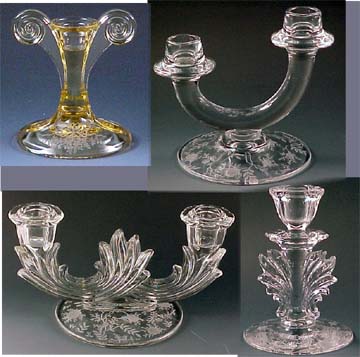National Depression Glass Association
Preserving America's Glass Manufacturing Heritage
Fostoria Glass Candleholders
by Kathy Eickholt
Fostoria Glass had a field day with candleholders. You will find
ones to hold one candle or two or three, in colors, in crystal,
etched, cut, with gold or silver, and yes, even plain. Combining
candlelight with glass is irresistible and even without the candles
these are beautiful, fanciful pieces. Fostoria made many, many
 candleholder shapes and we'll show only a few, just enough to give
you an idea of the incredible versatility and beauty.
candleholder shapes and we'll show only a few, just enough to give
you an idea of the incredible versatility and beauty.
The yellow candleholder in the top left is the June etching on topaz elegant glass. June is one of the best known and loved patterns - can you tell? The flower spray, bouquet tied with a ribbon bow and accented with second ribbon arc is simply beautiful. The scroll shape is pure art deco with its oval base, curved stem and scrolled top. Fostoria made June in blue, pink, crystal and topaz and the topaz seems a little more available and it is a wonderful sunshine color that makes you smile. These are stunning when paired with a large bowl for a console set. This is my favorite shape and I just love the deco shape with the gorgeous color and the etched base.
Another set candlesticks look like mushrooms to me but when you see them in person you realize they are actually more square, and maybe a little larger than you expect with the Versailles etch on the rolled over top. They are heavy, too, about a pound each. You can find this shape with other Fostoria Glass elegant depression era etches.
A candleholder that we're not able to show in the composite photo is a traditional shape with a round base and a cylindrical stem that has the candle cup at the top. You'll see very similar styles from other glass makers, and also you'll see metal ones in similar designs such as brass or pewter. The round base looks super with etches like Vesper that are bands. I believe you can find this in amber, crystal, medium blue and pink besides the green and etched with Vesper, Royal, Seville and likely more. If you find this candleholder unetched it can be more difficult to distinguish Fostoria from other makers.
Fostoria made an interesting shape, a rolled over hemisphere that is etched on the top. These look like miniature rolled rim console bowls and Fostoria used them for their brocade etches.
Moving along in time we come to candleholders from the 1950s-60s and the Baroque blank. Baroque is the design with fleur de lis pressed on the outside of many pieces, but the candleholders don't have this. Instead most have a grooved wave or scroll shape that's pretty distinctive.
There is a single light candleholder that looks like a cornucopia in Baroque that you'll find mainly in crystal but possibly some light blue as well. Fostoria used this shape for Meadow Rose, Chintz and Navarre etches. The Baroque shape on the lower left holds two candle tapers. This one is Chintz etched. I wanted to show you several candleholders with the Chintz etching so you can decide which you like the best. The candleholder on the lower right is the taller single light Baroque style. This has a sunburst design on the stem and the design is etched on the flat base. It is beautiful with any etch or plain because the sunburst rays really catch the light.
With all the Baroque candleholders you will want to check the tips and pointed scroll edges as these can be easily nicked or rubbed. It is easy to miss this sort of damage so if you buy online it's a good idea to ask the seller to double check the piece for you.
The more modern looking candleholder on the top right is shaped like a U and is called a duo candleholder. Fostoria used this same shape for Romance as well as the Chintz which we photographed. This duo style has the careful understated elegance of the mid-century modern era. Like the others, the design is etched on the underside base.
Most of the candleholders we see are in good condition, probably because people viewed them as "good" and kept them carefully with the fine crystal and china. The round rolled over shape tends to have rough spots on the inside bottom base rim and any of these could get scratched or nicked after 70 years.
The other place candleholders can get damaged is the cup that holds the candle itself. If candles burn down too closely to the socket the glass can crack and you may not notice this at first glance. If you decide that you're like me and want to own some of these, then it's a good idea to inquire about cracks around the candle cup, wear on the base and any pointed areas that would be easily damaged.
The last topic is what to call these - candles, candlesticks, candleholders or candle holders? To me a candle or candlestick could be the taper itself, not the holder so I usually call these candleholders as do many reference books. When you search in Google or on eBay use the search term candle* to get all the possible spellings.
I hope you enjoyed this quick tour of Fostoria Glass' elegant candleholders. There are many more shapes and designs than the few we showed you.
Webmaster's NOTE: The NDGA wishes to thank the author for permission to use this article. Kathy is a dealer from Midland, Michigan. Her web site is Cat Lady's Glass.